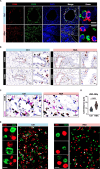Compromised C3b-VSIG4 axis between decidual NK cells and macrophages contributes to recurrent spontaneous abortion
- PMID: 39529122
- PMCID: PMC11556194
- DOI: 10.1186/s12967-024-05829-w
Compromised C3b-VSIG4 axis between decidual NK cells and macrophages contributes to recurrent spontaneous abortion
Abstract
NK cells and macrophages constitute the predominant immune cell subsets in the decidua during the first trimester of pregnancy, with macrophages typically adopting an anti-inflammatory phenotype. Conversely, in the third trimester, macrophages undergo a shift towards a pro-inflammatory phenotype concurrent with a reduction in NK cell numbers. The direct regulatory impact of NK cells on macrophage phenotype remains poorly explored. In our investigation, we observed that ICAM1+ macrophages stimulate the expression of intracellular C3 in LFA1+ decidual NK cells. Notably, Cathepsin W within NK cells exhibit the potential to generate active C3b fragments, effectively inhibit the proinflammatory phenotype of macrophages by binding to VSIG4. Our study unveils a direct regulatory mechanism orchestrated by decidual NK cells over macrophages, providing a potential pathogenic explanation for recurrent spontaneous abortion.
Keywords: Complement; Decidual natural killer cell; Macrophage; Recurrent spontaneous abortion; VSIG4.
© 2024. The Author(s).
Conflict of interest statement
Figures







References
-
- Trundley A, Moffett A. Human uterine leukocytes and pregnancy. Tissue Antigens. 2004. 10.1111/j.1399-0039.2004.00170.x. - PubMed
-
- Bulmer JN, Williams PJ, Lash GE. Immune cells in the placental bed. Int J Dev Biol. 2010;54:281–94. 10.1387/ijdb.082763jb. - PubMed
-
- Manaster I, Mandelboim O. The unique properties of uterine NK cells. Am J Reprod Immunol. 2010;63:434–44. 10.1111/j.1600-0897.2009.00794.x. - PubMed
-
- Hanna J, et al. Decidual NK cells regulate key developmental processes at the human fetal-maternal interface. Nat Med. 2006;12:1065–74. 10.1038/nm1452. - PubMed
MeSH terms
Grants and funding
- 2022YFA1103603/Key Technologies Research and Development Program
- 81930037/Innovative Research Group Project of the National Natural Science Foundation of China
- 82201943/Innovative Research Group Project of the National Natural Science Foundation of China
- 32300774/Innovative Research Group Project of the National Natural Science Foundation of China
- WK9100000059/Fundamental Research Funds for the Central Universities
LinkOut - more resources
Full Text Sources
Miscellaneous

